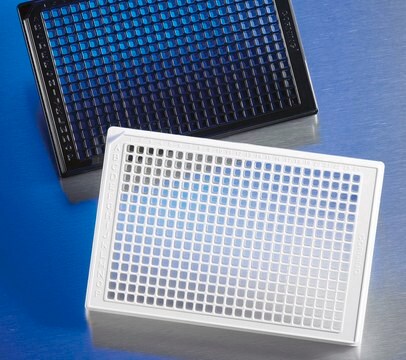SCC642
OCUG-1 Human Gallbladder Carcinoma Cell Line

Sinónimos:
OCUG-1 Human Gallbladder Carcinoma Cell Line, OCUG1, Osaka City University Gallbladder-1
Iniciar sesiónpara Ver la Fijación de precios por contrato y de la organización
About This Item
Código UNSPSC:
41106514
Productos recomendados
origen biológico
human
Nivel de calidad
envase
vial of ≥1X10⁶ vial
fabricante / nombre comercial
Millipore
técnicas
cell culture | mammalian: suitable
Condiciones de envío
liquid nitrogen
temp. de almacenamiento
−196°C
Aplicación
- Each vial contains > 1X106 viable cells.
- Cells are tested negative for infectious diseases by a Essential CLEAR Panel by Charles River Animal Diagnostic Services.
- Cells are verified to be of human origin and negative for interspecies contamination from mouse, rat, Chinese hamster, Golden Syrian hamster, and nonhuman primate (NHP) as assessed by a Contamination Clear panel by Charles River Animal Diagnostic Services
- Cells are negative for mycoplasma contamination.
Características y beneficios
The OCUG-1 human gallbladder carcinoma cell line has been used to study hapatobiliary cancer in genome-wide mutation and expression studies.
Descripción de destino
SCC642 (OCUG-1), the human gallbladder carcinoma cell line, was isolated from the peritoneal effusion of a Japanese male patient with malignant gallbladder carcinoma. Although the primary tumor was diagnosed as a poorly differentiated adenocarcinoma, and the reconstituted tumors in nude mice also exhibited the same histologic characteristics, the OCUG-1 cells were found to abundantly express the Tumor-Associated Antigen 4 (TA-4), which had been identified as a serum marker for cervical squamous cell carcinoma. This led Yamada et al. to propose that OCUG-1 might be a transitional form between adenocarcinoma and squamous cell carcinoma and represented a useful model system for investigating the squamatization processes. Subsequently, one of the major components of TA-4, the Squamous Cell Carcinoma Antigen 1 (SCCA1, also known as SERPINB3, the Serine Protease Inhibitor Clade B Member 3), was shown to induce the squamatization and disease progression in pancreatic cancer by the inhibition of the degradation of the MYC proto-oncogene.
As one of the relatively few available gallbladder cancer cell lines, OCUG-1 has been examined as a representative hapatobiliary cancer in genome-wide mutation and expression studies. In one such study, Scherer et al. noted that the expression profile of the known primary gallbladder tumor markers is not commonly shared by the gallbladder cancer cell lines and suggested that investigators choose their cellular platforms based not only on the tissue origin of the tumors but also on the driver gene expression patterns underlying the specific mechanisms of tumorigenesis.
Source
SCC642 cell line was isolated from the peritoneal effusion of a 43 year old Japanese male patient with malignant gallbladder carcinoma.
References
1. Yamada N, Chung Y, Ohtani H, Ikeda T, Onoda N, Sawada T, Nishiguchi Y, Hasuma T, Sowa M. Establishment and characterization of a new human gallbladder carcinoma cell line (OCUG-1) producing TA-4. Int J Oncol. 1997 Jun;10(6):1251-5.
As one of the relatively few available gallbladder cancer cell lines, OCUG-1 has been examined as a representative hapatobiliary cancer in genome-wide mutation and expression studies. In one such study, Scherer et al. noted that the expression profile of the known primary gallbladder tumor markers is not commonly shared by the gallbladder cancer cell lines and suggested that investigators choose their cellular platforms based not only on the tissue origin of the tumors but also on the driver gene expression patterns underlying the specific mechanisms of tumorigenesis.
Source
SCC642 cell line was isolated from the peritoneal effusion of a 43 year old Japanese male patient with malignant gallbladder carcinoma.
References
1. Yamada N, Chung Y, Ohtani H, Ikeda T, Onoda N, Sawada T, Nishiguchi Y, Hasuma T, Sowa M. Establishment and characterization of a new human gallbladder carcinoma cell line (OCUG-1) producing TA-4. Int J Oncol. 1997 Jun;10(6):1251-5.
Almacenamiento y estabilidad
OCUG-1 cells should be stored in liquid nitrogen. The cells can be cultured for at least 10 passages without significantly affecting cell marker expression and function.
Otras notas
This product is intended for sale and sold solely to academic institutions for internal academic research use per the terms of the “Academic Use Agreement” as detailed in the product documentation. For information regarding any other use, please contact licensing@milliporesigma.com.
Cláusula de descargo de responsabilidad
Unless otherwise stated in our catalog or other company documentation accompanying the product(s), our products are intended for research use only and are not to be used for any other purpose, which includes but is not limited to, unauthorized commercial uses, in vitro diagnostic uses, ex vivo or in vivo therapeutic uses or any type of consumption or application to humans or animals.
Código de clase de almacenamiento
10 - Combustible liquids
Clase de riesgo para el agua (WGK)
WGK 2
Punto de inflamabilidad (°F)
Not applicable
Punto de inflamabilidad (°C)
Not applicable
Certificados de análisis (COA)
Busque Certificados de análisis (COA) introduciendo el número de lote del producto. Los números de lote se encuentran en la etiqueta del producto después de las palabras «Lot» o «Batch»
¿Ya tiene este producto?
Encuentre la documentación para los productos que ha comprado recientemente en la Biblioteca de documentos.
Nuestro equipo de científicos tiene experiencia en todas las áreas de investigación: Ciencias de la vida, Ciencia de los materiales, Síntesis química, Cromatografía, Analítica y muchas otras.
Póngase en contacto con el Servicio técnico